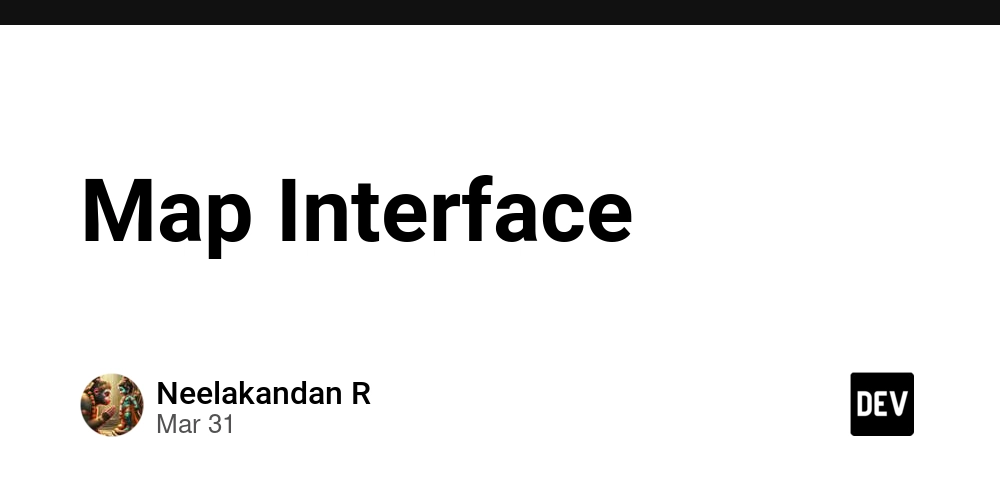Map Interface
Map Interface The map interface in Java is a structure that holds a set of key-value pairs where each key is unique and points to one value only. It is a component of the java.util package and is being widely used in Java programming to structure and get data in an ordered manner. A Map is useful if you have to search, update or delete elements on the basis of a key. Class------------Description HashMap----------HashMap is the implementation of Map, but it doesn't maintain any order. LinkedHashMap-----LinkedHashMap is the implementation of Map. It inherits HashMap class. It maintains insertion order. TreeMap-----------TreeMap is the implementation of Map and SortedMap. It maintains ascending order. Useful methods of Map interface V put(Object key, Object value)--It is used to insert an entry in the map. void putAll(Map map)---It is used to insert the specified map in the map. V putIfAbsent(K key, V value)---It inserts the specified value with the specified key in the map only if it is not already specified. V remove(Object key)---It is used to delete an entry for the specified key. boolean remove(Object key, Object value)---It removes the specified values with the associated specified keys from the map. Set keySet()---It returns the Set view containing all the keys. boolean containsValue(Object value)---This method returns true if some value equal to the value exists within the map, else return false. boolean containsKey(Object key)---his method returns true if some key equal to the key exists within the map, else return false. boolean equals(Object o)---It is used to compare the specified Object with the Map. V get(Object key)---This method returns the object that contains the value associated with the key. boolean isEmpty()---This method returns true if the map is empty; returns false if it contains at least one key. ** V replace(K key, V value)**--It replaces the specified value for a specified key. int size()---This method returns the number of entries in the map. Map.Entry Interface Map.Entry is an inner interface of the Map interface which represents a single pair of key-value in a map. It additionally allows one to get a map and to iterate over its entries, convert the map to a set of keys/values, etc. It returns a collection-view of the map, whose elements are of this class. It provides methods to get keys and values. K getKey()---It is used to obtain a key. V getValue()---It is used to obtain value. int hashCode()---It is used to obtain hashCode. ** V setValue(V value)**---It is used to replace the value corresponding to this entry with the specified value. boolean equals(Object o)---It is used to compare the specified object with the other existing objects. import java.util.*; public class MapExample1 { public static void main(String[] args) { Map map=new HashMap(); //Adding elements to map map.put(1,"Amit"); map.put(5,"Rahul"); map.put(2,"Jai"); map.put(6,"Amit"); //Traversing Map Set set=map.entrySet();//Converting to Set so that we can traverse Iterator itr=set.iterator(); while(itr.hasNext()){ //Converting to Map.Entry so that we can get key and value separately Map.Entry entry=(Map.Entry)itr.next(); System.out.println(entry.getKey()+" "+entry.getValue()); } } } Output: 1 Amit 2 Jai 5 Rahul 6 Amit HashMap HashMap is an important data structure in Java which implements the Map interface. In this way, it provides a scheme for storing of key-value pairs. A HashMap has each key unique and only has one value for each key. This enables the lookup of values by their keys that are paired with them. Example: HashMapExample.java import java.util.HashMap; import java.util.Map; public class HashMapExample { public static void main(String[] args) { // Creating a HashMap to store student IDs and their corresponding names Map studentMap = new HashMap(); // Adding some student records to the HashMap studentMap.put(1001, "John Smith"); studentMap.put(1002, "Emily Brown"); studentMap.put(1003, "Michael Johnson"); // Retrieving and printing a student's name based on their ID int studentIdToFind = 1002; String studentName = studentMap.get(studentIdToFind); if (studentName != null) { System.out.println("Student with ID " + studentIdToFind + " is: " + studentName); } else { System.out.println("Student with ID " + studentIdToFind + " not found."); } // Iterating over the entries of the HashMap and printing each key-value pair System.out.println("Student Records:"); for (Map.Entry entry : studentMap.entrySet()) { System.out.println("ID: " + entry.getKey() + ", Name: " + entry.getValue());

Map Interface
The map interface in Java is a structure that holds a set of key-value pairs where each key is unique and points to one value only. It is a component of the java.util package and is being widely used in Java programming to structure and get data in an ordered manner. A Map is useful if you have to search, update or delete elements on the basis of a key.
Class------------Description
HashMap----------HashMap is the implementation of Map, but it doesn't maintain any order.
LinkedHashMap-----LinkedHashMap is the implementation of Map. It inherits HashMap class. It maintains insertion order.
TreeMap-----------TreeMap is the implementation of Map and SortedMap. It maintains ascending order.
Useful methods of Map interface
V put(Object key, Object value)--It is used to insert an entry in the map.
void putAll(Map map)---It is used to insert the specified map in the map.
V putIfAbsent(K key, V value)---It inserts the specified value with the specified key in the map only if it is not already specified.
V remove(Object key)---It is used to delete an entry for the specified key.
boolean remove(Object key, Object value)---It removes the specified values with the associated specified keys from the map.
Set keySet()---It returns the Set view containing all the keys.
boolean containsValue(Object value)---This method returns true if some value equal to the value exists within the map, else return false.
boolean containsKey(Object key)---his method returns true if some key equal to the key exists within the map, else return false.
boolean equals(Object o)---It is used to compare the specified Object with the Map.
V get(Object key)---This method returns the object that contains the value associated with the key.
boolean isEmpty()---This method returns true if the map is empty; returns false if it contains at least one key.
**
V replace(K key, V value)**--It replaces the specified value for a specified key.
int size()---This method returns the number of entries in the map.
Map.Entry Interface
Map.Entry is an inner interface of the Map interface which represents a single pair of key-value in a map. It additionally allows one to get a map and to iterate over its entries, convert the map to a set of keys/values, etc. It returns a collection-view of the map, whose elements are of this class. It provides methods to get keys and values.
K getKey()---It is used to obtain a key.
V getValue()---It is used to obtain value.
int hashCode()---It is used to obtain hashCode.
**
V setValue(V value)**---It is used to replace the value corresponding to this entry with the specified value.
boolean equals(Object o)---It is used to compare the specified object with the other existing objects.
import java.util.*;
public class MapExample1 {
public static void main(String[] args) {
Map map=new HashMap();
//Adding elements to map
map.put(1,"Amit");
map.put(5,"Rahul");
map.put(2,"Jai");
map.put(6,"Amit");
//Traversing Map
Set set=map.entrySet();//Converting to Set so that we can traverse
Iterator itr=set.iterator();
while(itr.hasNext()){
//Converting to Map.Entry so that we can get key and value separately
Map.Entry entry=(Map.Entry)itr.next();
System.out.println(entry.getKey()+" "+entry.getValue());
}
}
}
Output:
1 Amit
2 Jai
5 Rahul
6 Amit
HashMap
HashMap is an important data structure in Java which implements the Map interface. In this way, it provides a scheme for storing of key-value pairs. A HashMap has each key unique and only has one value for each key. This enables the lookup of values by their keys that are paired with them.
Example:
HashMapExample.java
import java.util.HashMap;
import java.util.Map;
public class HashMapExample {
public static void main(String[] args) {
// Creating a HashMap to store student IDs and their corresponding names
Map studentMap = new HashMap<>();
// Adding some student records to the HashMap
studentMap.put(1001, "John Smith");
studentMap.put(1002, "Emily Brown");
studentMap.put(1003, "Michael Johnson");
// Retrieving and printing a student's name based on their ID
int studentIdToFind = 1002;
String studentName = studentMap.get(studentIdToFind);
if (studentName != null) {
System.out.println("Student with ID " + studentIdToFind + " is: " + studentName);
} else {
System.out.println("Student with ID " + studentIdToFind + " not found.");
}
// Iterating over the entries of the HashMap and printing each key-value pair
System.out.println("Student Records:");
for (Map.Entry entry : studentMap.entrySet()) {
System.out.println("ID: " + entry.getKey() + ", Name: " + entry.getValue());
}
// Checking if a student ID exists in the HashMap
int idToCheck = 1004;
boolean exists = studentMap.containsKey(idToCheck);
System.out.println("Student with ID " + idToCheck + " exists in records: " + exists);
}
}
Output:
Student with ID 1002 is: Emily BrownStudent Records:
ID: 1001, Name: John Smith
ID: 1002, Name: Emily Brown
ID: 1003, Name: Michael Johnson
Student with ID 1004 exists in records: false
LinkedHashMap
LinkedHashMap is a class in Java that extends HashMap and implements the Map interface. It resembles Hashmap in functionality but maintains a predictable iteration order, that is, the order in which keys were inserted into the map (insertion-order). This in turn makes LinkedHashMap a good candidate for cases when the order of insertion needs to be preserved.
LinkedHashMapExample.java
import java.util.LinkedHashMap;
import java.util.Map;
public class LinkedHashMapExample {
public static void main(String[] args) {
// Creating a LinkedHashMap to store student IDs and their corresponding names
Map studentMap = new LinkedHashMap<>();
// Adding some student records to the LinkedHashMap
studentMap.put(1001, "John Smith");
studentMap.put(1002, "Emily Brown");
studentMap.put(1003, "Michael Johnson");
// Iterating over the entries of the LinkedHashMap and printing each key-value pair
System.out.println("Student Records:");
for (Map.Entry entry : studentMap.entrySet()) {
System.out.println("ID: " + entry.getKey() + ", Name: " + entry.getValue());
}
}
}
Output:
Student Records:
ID: 1001, Name: John Smith
ID: 1002, Name: Emily Brown
ID: 1003, Name: Michael Johnson
TreeHashMap
TreeMap in Java is a sorted map implementation that stores key-value pairing in a Red-Black tree structure. It guarantees that the elements are arranged in relation to their keys, either naturally or by a user-defined comparator.
Example:
TreeMapExample.java
import java.util.*;
public class TreeMapExample {
public static void main(String[] args) {
// Creating a TreeMap to store student IDs and their corresponding names
TreeMap studentMap = new TreeMap<>();
// Adding some student records to the TreeMap
studentMap.put(1003, "Michael Johnson");
studentMap.put(1001, "John Smith");
studentMap.put(1002, "Emily Brown");
// Iterating over the entries of the TreeMap and printing each key-value pair
System.out.println("Student Records:");
for (Map.Entry entry : studentMap.entrySet()) {
System.out.println("ID: " + entry.getKey() + ", Name: " + entry.getValue());
}
}
}
Output:
Student Records:
ID: 1001, Name: John Smith
ID: 1002, Name: Emily Brown
ID: 1003, Name: Michael Johnson











































































































































































![[The AI Show Episode 142]: ChatGPT’s New Image Generator, Studio Ghibli Craze and Backlash, Gemini 2.5, OpenAI Academy, 4o Updates, Vibe Marketing & xAI Acquires X](https://www.marketingaiinstitute.com/hubfs/ep%20142%20cover.png)




























































































































![[DEALS] The Premium Learn to Code Certification Bundle (97% off) & Other Deals Up To 98% Off – Offers End Soon!](https://www.javacodegeeks.com/wp-content/uploads/2012/12/jcg-logo.jpg)


![From drop-out to software architect with Jason Lengstorf [Podcast #167]](https://cdn.hashnode.com/res/hashnode/image/upload/v1743796461357/f3d19cd7-e6f5-4d7c-8bfc-eb974bc8da68.png?#)








































































































.png?#)























.webp?#)










_Christophe_Coat_Alamy.jpg?#)
 (1).webp?#)




































































































![Apple Considers Delaying Smart Home Hub Until 2026 [Gurman]](https://www.iclarified.com/images/news/96946/96946/96946-640.jpg)
![iPhone 17 Pro Won't Feature Two-Toned Back [Gurman]](https://www.iclarified.com/images/news/96944/96944/96944-640.jpg)
![Tariffs Threaten Apple's $999 iPhone Price Point in the U.S. [Gurman]](https://www.iclarified.com/images/news/96943/96943/96943-640.jpg)



































































































































